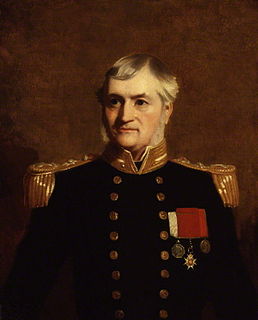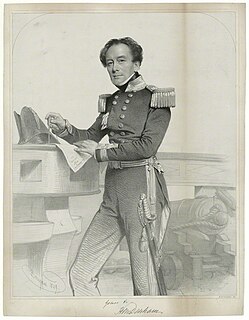Byron Drury | |
|---|---|
| Born | 1815 Harrow on the Hill, London, England |
| Died | 1888 (aged 72–73) |
| Allegiance | |
| Service/ | |
| Rank | Admiral |
Admiral Byron Drury (1815–1888) was a British naval officer.
Byron Drury | |
|---|---|
| Born | 1815 Harrow on the Hill, London, England |
| Died | 1888 (aged 72–73) |
| Allegiance | |
| Service/ | |
| Rank | Admiral |
Admiral Byron Drury (1815–1888) was a British naval officer.
Drury was born in Harrow on the Hill, the son of Rev. Henry Drury, of Harrow School; at which place he, and his father, Dr. Drury, were masters for about 70 years. [1]
Byron Drury entered the Royal Naval College in 1828; and embarked, 13 August 1830, as a Volunteer, on board HMS Aetna surveying vessel, under the command of Captain Edward Belcher. He afterwards served for upwards of three years, latterly as a midshipman, in HMS Rainbow, under Captain Sir John Franklin, on the Mediterranean station; and, joining next HMS Racehorse under Captain Sir James Everard Home, took an active part, as mate, in the siege of Pará in Brazil in 1835, where he was for several days in action with the enemy’s batteries. [2] Landing at night he conducted over 200 Brazilians to the beach for embarkation from the midst of the insurgents. [3] [4] He was also involved in surveying the Pará River. [5]
Drury was with Sir Gordon Bremer, in HMS Alligator, he subsequently assisted in surveying the harbour at Port Essington, in South Australia, during the formation of that place into a settlement. [2]
On 30 November 1839 he became an acting-lieutenant by which time HMS Alligator was in Indian waters. He was engaged in most of the hostilities against the Chinese. He commanded a division of boats at the first capture of Canton in 1841, [6] For his services he received the China medal, [3] and officially promoted, by commission dated 8 June 1841. [2]
On 6 July 1841 he transferred to HMS Calliope under Captain Augustus Leopold Kuper While in Calliope, he proved to be particularly useful by his valuable exertions in surveying and sounding the channels in the Yang-tse-Kiang, preparatory to the ascent of the British fleet to Nanking. [2]
Drury’s next appointments was on 30 September 1843, to the steamer HMS Shearwater, under Captain Charles Gepp Robinson, which was employed in surveying the west coast of Scotland. On 10 February 1845 he transferred to HMS Herald, under Captain Henry Kellett, fitting for the Pacific. He was superseded from the latter ship on promotion to the rank of Commander on 22 May 1845. [2] In February 1846, he returned to Shearwater and continued to work on the survey of the west coast of Scotland. [5]

In December 1850 he took command of HMS Pandora, which was employed from 20 until June 1856 surveying the coasts of New Zealand, continuing the work of John Lort Stokes in HMS Acheron. [5] He was thanked and recommended to the Admiralty by the Governor, Sir George Grey. On leaving the colony he received a testimonial and a service of plate from the Chamber of Commerce and a portion of the inhabitants of Auckland. He was a Fellow of the Royal Geographical Society. [3] [7]
He was promoted to captain in 1857 and retired. He was promoted to captain in 1866, to rear-admiral in 1875 and vice-admiral in 1879. [3]

Drury died in Cheltenham in November 1888, [3] and there is a memorial to his death in St Mary's, Harrow on the Hill.
He married, 9 June 1846, Helen Stewart (died 1881), daughter of Robert Morris of Moorburn, Ayrshire. [2]
Drury Inlet in the Queen Charlotte Strait region of the Central Coast of British Columbia, Canada, extending west from Wells Passage to the northwest of North Broughton Island, northwest of the town of Port Hardy is named after him. [8]
As captain of HMS Pandora, he took part in the survey of New Zealand that led to the publication of the New Zealand Pilot. [9] This included Manukau Harbour in 1853. [10] - nearby Drury, New Zealand is named after him.

Admiral Sir Augustus Leopold Kuper was a Royal Navy officer known for his commands in the far east.

Admiral Sir James Whitley Deans Dundas GCB was a Royal Navy officer. He took part in the Napoleonic Wars, first as a junior officer when he took part in the Anglo-Russian invasion of Holland in Autumn 1799 and later as a commander when he was in action at Copenhagen Dockyard shortly after the capture of that City in August 1807. He also served as Whig Member of Parliament for Greenwich and then for Devizes and became First Naval Lord in the First Russell ministry in July 1847 and in that role his service was dominated by the needs of Whig party. He was appointed Commander-in-Chief in the Mediterranean in 1852 and led all naval operations in the Black Sea including the bombardment of Sevastopol in October 1854 during the Crimean War.

Admiral John Lort Stokes, RN was an officer in the Royal Navy who travelled on HMS Beagle for close to eighteen years.

Vice Admiral William Fitzwilliam Owen, was a British naval officer and explorer. He is best known for his exploration of the west and east African coasts, discovery of the Seaflower Channel off the coast of Sumatra and for surveying the Canadian Great Lakes.

Sir George Henry Richards was Hydrographer of the Royal Navy from 1863 to 1874.

Admiral of the Fleet Sir William Parker, 1st Baronet, GCB, was a Royal Navy officer. As a captain's servant he took part in the Battle of The Glorious First of June in June 1794 during the French Revolutionary Wars and, as a captain, he participated in the capture of the French ships Marengo and Belle Poule at the action of 13 March 1806 during the Napoleonic Wars. He was detached on an independent command on the Tagus in September 1831 with a mission to protect British interests during the Portuguese Civil War. As Commander-in-chief of the East Indies and China Station, he provided naval support at various actions between 1841 and 1842 during the First Opium War. Appointed Commander-in-Chief, Mediterranean Fleet in February 1845, he was briefly First Naval Lord in the First Russell ministry from 13 July 1846 to 24 July 1846 but gave up the role due to ill health before returning to his command with the Mediterranean Fleet.

Vice Admiral Sir Henry Kellett, was a British naval officer and explorer.

Vice Admiral Sir Henry Mangles Denham was a Royal Navy officer who went on to be Commander-in-Chief, Pacific Station.

Admiral Sir Baldwin Wake Walker, 1st Baronet, was Surveyor of the Navy from 1848 to 1861. and was responsible for the Royal Navy's warship construction programme during the 1850s naval arms race and at the time of the introduction of the Ironclad warship; it was his decision to build HMS Warrior. He was created 1st Baronet Wake Walker, of Oakley House in 1856.

Francis Price Blackwood was a British naval officer who while posted at several different locations during his time in the Royal Navy, spent much of his time posted in colonial Australia and was an instrumental pioneer of regions near Australia's east coast and nearby islands.

Admiral Charles Ramsay Drinkwater Bethune CB was a British officer of the Royal Navy. He rose to the rank of Admiral during his career.
Alexander Thomas Emeric Vidal was an officer of the Royal Navy. He became an accomplished surveyor, and reached the rank of vice-admiral.
Rear Admiral Frederick Thomas Pelham, was a Royal Navy officer who went on to be Second Naval Lord.

Henry Joseph Thomas Drury, known as Harry Drury, was an English educator, classical scholar, and friend of Lord Byron.

Vice-Admiral Sir Thomas Herbert, KCB, was a British Royal Navy officer. He served in the Napoleonic Wars, War of 1812, and First Anglo-Chinese War. From 1847 to 1849, he was commodore of the South East Coast of America Station. Herbert served as Member of Parliament for Dartmouth as a Conservative from 1852 to 1857.
John Washington was an officer of the Royal Navy, a hydrographer, and a founding member of the Royal Geographical Society of London.
Thomas Graves was an officer of the Royal Navy and naturalist who worked extensively as a surveyor in the Mediterranean.

HMS Pandora was a 3-gun brig of the Royal Navy, in service from 1833 to 1862.

Charles Gepp Robinson was a Royal Navy Officer and hydrographic surveyor particularly noted for his survey work in the west of Scotland.
Rear Admiral Edward James Bedford was a Royal Navy officer noted for his work as a surveyor, particularly in Scotland.